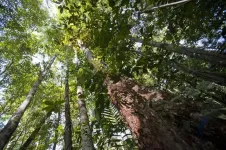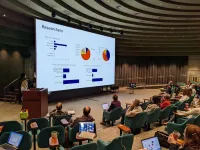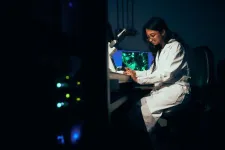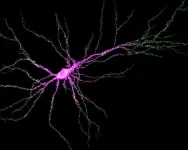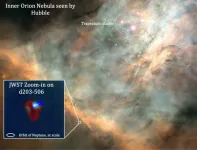(Press-News.org) Tropical trees are at the heart of this study. They are essential for climate regulation, maintaining biodiversity and providing crucial resources for many local communities. Understanding how they evolve genetically is therefore of vital importance for preserving biological diversity and finding sustainable solutions for tropical forest adaptation to the environmental pressures they face.
The aim of this study was to identify the mutations accumulated during growth by two specimens of tropical trees sampled in French Guiana, a French overseas department covered to 96% by tropical forest. To do this, the scientists investigated the distribution of these mutations along the trees’ architecture, in relation to possible impacts of light (UV), as well as their transmission to embryos in the fruits.
By sequencing the DNA of branches exposed differently to sunlight, the researchers found no effect of UVs in the appearance of mutations in these two tropical trees, unlike what is seen in mammals. Although the majority of these mutations are rare in the tissues of these trees, this study reveals that, owing to their large number, they are transmitted to the fruits and therefore to the next generation. These previously ignored rare mutations add to the reservoir of genetic diversity in these tropical species. This new raw material for the engine of evolution is essential for adapting to environmental change.
This major advance, made possible by new genome sequencing and analysis tools, considerably enriches our understanding of the biology of tropical trees.
A Swiss army knife at the service of trees
Thanks to recent advances in genomics, two novel high-quality genomes from the tropical trees, Dicorynia guianensis and Sextonia rubra, now offer an in-depth exploration of tree genetics. Sampling leaves from 18 branches of these over 40-metre-tall trees has made it possible to compare leaf DNA sequencing data with reference genomes from the base of the trunk and to detect new mutations that have appeared along the branches during the growth of these trees, using cutting-edge methods transferred from human oncology to plant genomics. The mutations detected are mostly very rare in the tissues and affect all the chromosomes of the individuals. The heritability of these new mutations has been demonstrated by their targeted sequencing in fruits, opening up new perspectives for understanding the sources of genetic diversity in tropical trees.
END
Unveiling rare diversity: the origin of heritable mutations in trees
2024-02-29
ELSE PRESS RELEASES FROM THIS DATE:
Tandem cycling linked to improved health for those with Parkinson’s, care partners
2024-02-29
EMBARGOED FOR RELEASE UNTIL 4 P.M. ET, THURSDAY, FEBRUARY 29, 2024
MINNEAPOLIS – Pedaling on a stationary bicycle built for two may improve the health and well-being for both people with Parkinson’s disease and their care partners, according to a small, preliminary study released today, February 29, 2024, that will be presented at the American Academy of Neurology’s 76th Annual Meeting taking place April 13–18, 2024, in person in Denver and online.
“Our study found that a unique cycling program that pairs people with Parkinson’s disease with their care partners can improve ...
Preprints raise possibility of rethinking the peer-review process as they become more widely used and accepted
2024-02-29
Preprints raise possibility of rethinking the peer-review process as they become more widely used and accepted – new article encourages their growing momentum and provides recommendations to empower researchers to provide open and constructive peer review for preprints
#####
In your coverage, please use this URL to provide access to the freely available paper in PLOS Biology: http://journals.plos.org/plosbiology/article?id=10.1371/journal.pbio.3002502
Article Title: Recommendations for accelerating ...
A new channel for touch
2024-02-29
Every hug, every handshake, every dexterous act engages and requires touch perception. Therefore, it is essential to understand the molecular basis of touch. “Until now, we had known that the ion channel – Piezo2 – is required for touch perception, but it was clear that this protein alone cannot explain the entirety of touch sensation,” says Professor Gary Lewin, head of the Molecular Physiology of Somatic Sensation Lab at the Max Delbrück Center.
For over 20 years Lewin has been studying the molecular basis of the sensation ...
Scientists identify new ‘regulatory’ function of learning and memory gene common to all mammalian brain cells
2024-02-29
Johns Hopkins Medicine neuroscientists say they have found a new function for the SYNGAP1 gene, a DNA sequence that controls memory and learning in mammals, including mice and humans.
The finding, published March 1 in Science, may affect the development of therapies designed for children with SYNGAP1 mutations, who have a range of neurodevelopmental disorders marked by intellectual disability, autistic-like behaviors, and epilepsy.
In general, SYNGAP1, as well as other genes, control learning and memory by making proteins that regulate the strength of synapses — the connections between brain ...
Ultraviolet “winds” erode a young star’s protoplanetary disk in Orion Nebula
2024-02-29
Ultraviolet “winds” from nearby massive stars are stripping the gas from a young star’s protoplanetary disk, causing it to rapidly lose mass, according to a new study. It reports the first directly observed evidence of far-ultraviolet (FUV)-driven photoevaporation of a protoplanetary disk. The findings, which use observations from the James Web Space Telescope (JWST), provide new insights into the constraints of gas giant planet formation, including in our own Solar System. Young low-mass stars are often surrounded by relatively short-lived protoplanetary disks of dust and gas, which provide the raw materials from which planets ...
Pelagic fish more impacted by human pressures and protections than benthic species
2024-02-29
Pelagic fish – species that occupy the water column of the open ocean, neither near the bottom nor near the shore – are more impacted by both human pressure and protection than bottom-dwelling benthic species, researchers report. The findings highlight the need for increased marine protection in remote pelagic locations. Body size is a universal biological property that influences a range of ecological processes in marine ecosystems. Measuring body-size-structured variation can be a useful framework for understanding and predicting the impacts of overfishing or the success ...
Climate change is altering the seasonal pattern of river flow globally
2024-02-29
Climate change is altering the seasonality of river flow, particularly at high northern latitudes, according to a new study. Patterns in river flow vary with the seasons – a cycle that plays a critical role in floods and droughts, water security, and the health of biodiversity and ecosystems worldwide. Although recent studies have shown that climate change has already altered river flow seasonality (RFS), much of the evidence is limited to local regions or fails to consider the impact of climate change explicitly, independent of other human impacts to river flow. Consequently, the impact of climate warming on RFS isn’t ...
Conventional supply-side energy policies overlook benefits of demand-side policy approaches
2024-02-29
Energy security is a top priority across all levels of society because a host of global disruptions threaten energy systems and the critical functions they support. Most often, policymakers rely on policies and measurement indicators focused on energy supply to enhance energy security while ignoring demand-side possibilities. However, in a Policy Forum, Nuno Bento and colleagues argue that energy security is not solely security of supply; this limited focus fails to capture the full spectrum of vulnerability to energy crises. “Energy security is more than security ...
Radiation from massive stars shapes planetary systems
2024-02-29
How do planetary systems such as the Solar System form? To find out, CNRS scientists taking part in an international research team1 studied a stellar nursery, the Orion Nebula, using the James Webb Space Telescope2. By observing a protoplanetary disc named d203-506, they have discovered the key role played by massive stars in the formation of such nascent planetary systems3.
These stars, which are around 10 times more massive, and more importantly 100,000 times more luminous than the Sun, expose any planets forming in such systems nearby to very intense ultraviolet radiation. Depending on the mass of the star at the centre of the planetary system, this radiation can either help planets to ...
Climate change disrupts seasonal flow of rivers
2024-02-29
Climate change is disrupting the seasonal flow of rivers in the far northern latitudes of America, Russia and Europe and is posing a threat to water security and ecosystems, according to research published today.
A team of scientists led by the University of Leeds analysed historical data from river gauging stations across the globe and found that 21% of them showed significant alterations in the seasonal rise and fall in water levels.
The study used data-based reconstructions and state-of-the-art simulations to show that river flow is now far less likely to vary with the seasons in latitudes ...
